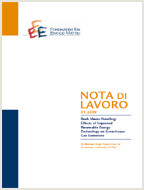Adaptation, Mitigation and “Green” R&D to Combat Global Climate Change. Insights From an Empirical Integrated Assessment Exercise

14.02.2010
Francesco Bosello
Q25, Q28
Climate Change Impacts, Mitigation, Adaptation, Integrated Assessment
Climate Change and Sustainable Development
Carlo Carraro
This work develops a framework for the analysis at the macro-level of the relationship between adaptation and mitigation policies. The FEEM-RICE growth model with stock pollution, endogenous R&D investment and emission abatement is enriched with a planned-adaptation module where a defensive capital stock is built through adaptation investment. Within this framework the optimal path of planned adaptation, the optimal inter and intra temporal mix between adaptation, mitigation and investment in R&D, and the sensitivity of a strategy to each other is identified. The major conclusions of this research show that adaptation, mitigation and R&D are strategic complements as all concur together to the solution of the climate change problem; nonetheless the possibility to adapt reduces the need to mitigate and partly crowds out other forms of investment like those in R&D. The optimal intertemporal distribution of strategies is also described: it requires to anticipate mitigation effort that should start already when climate damages are low and postpone adaptation intervention until they are substantial. Thus the possibility to adapt is not a justification to delay abatement activities. A sensitivity analysis demonstrates the robustness of these results to different parameterizations, in particular to changes in expected climate-change damages and in the discount rates.
